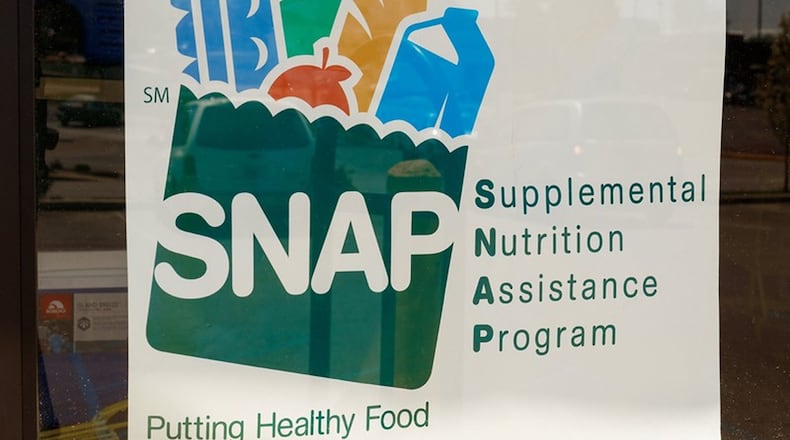As Georgia residents began to learn how to navigate a pandemic, the number of households receiving food stamps year-over-year had begun to decline, but, in recent months, enrollment has started creeping up again.
At the same time, fewer Georgians are receiving welfare benefits this year than last, a downward trend that’s existed for more than a decade as government officials sought to reduce the rolls.
While there are plenty of positive signs in Georgia’s economy — including record-low unemployment — increased prices for daily items such as groceries and fuel may have caused families to reevaluate their need for financial assistance.
But instead of seeking help from the welfare program, those experiencing financial hardship have turned to the Supplemental Nutrition Assistance Program, the formal name of the food stamps program.
Food stamp enrollment reached a pandemic peak of 905,000 households in September 2020 and has yo-yoed since then, according to Division of Family and Children Services data provided to The Atlanta Journal-Constitution. DFCS administers the state’s food stamp and welfare programs.
For the 2022 fiscal year that ended June 30, enrollment fell to about 724,000 households in September and reached a peak of about 788,000 households in March.
The number of households receiving food stamps has grown by about 48,000 from the same time last year. In June, the most recent numbers available, 778,000 households received about $251 million in food stamps, averaging about $322 per household.
Officials with the Department of Human Services, which manages DFCS, said food stamp enrollment is seasonal. Sometimes families need more help with groceries during the summer months when children are at home from school. Enrollment also typically decreases in December of each year, which officials say is caused by lags in recipients reapplying for the annual benefit.
An increase in benefits of about $100 due to the pandemic ended in May, bringing the average monthly benefit down by about that much between May and June.
Ife Finch Floyd, an analyst with the left-leaning Georgia Budget and Policy Institute, said a number of factors could have led to more families seeking food stamps.
“Households and individuals have felt the loss of that $95 on average per household,” she said. “Maybe $95 for people who make a middle-class income is not that much, but when you’re on a fixed income, those additional dollars — whether it’s $10 or $95 — are really, really meaningful when you’re purchasing food.”
The state’s food stamp rolls shrunk after “work requirements” were reinstated in several Georgia counties in 2016 with plans to go statewide in April 2020.
The federal work rules required “able-bodied adults without dependents” between the ages of 18 and 49 to work at least 20 hours a week or be engaged in some sort of education or work training. They were given three months to find a job or training program before losing their benefits.
About 600,000 fewer people received food stamps in 2019 than in 2013.
The work requirements were abandoned once the coronavirus pandemic began, scrapping plans for the statewide rollout. The work requirements will remain waived as long as the country continues to be in a health emergency as declared by the federal government.
State officials and advocates, meanwhile, say there could be a number of reasons for the decrease in the Temporary Assistance for Needy Families program, commonly known as welfare. The decline of nearly 1,200 households in the past year — despite the pandemic — follows a long trend of fewer people receiving public cash benefits.
“(Welfare) is structured to be a temporary support and to try to assist those that the state believes are truly, truly needy — and, certainly, we can debate who is needy,” Floyd said. “SNAP is more sensitive to households economic needs than a program like TANF.”
The criteria to qualify for TANF are more strict than for food stamps, DFCS officials said. The agency doesn’t track why welfare recipients leave the rolls. Recipients have to qualify annually and often they choose not to seek renewal, officials said.
In June 2021, welfare benefits were granted to 7,358 Georgia households, according to DFCS data. By June 2022, that number was down to 6,190.
That’s a decrease of nearly 81% since 2006, the earliest year for which DFCS could provide data, when 33,302 households received welfare benefits.
To be eligible for welfare in Georgia, a family of three must have a gross income below $784 a month. That same family could have a monthly gross income of up to $2,311 and still qualify for food stamps.
Since Congress passed sweeping changes to the federal welfare program in 1996, the number of households receiving benefits has consistently dropped in Georgia and across the country. Changes implemented in the ‘90s gave states more control over how to run welfare, which has long been politically stigmatized.
In Georgia, state officials require welfare recipients to work or participate in training for at least 30 hours each week. Those who sign up get access to job-searching assistance, or, if necessary, they receive help finishing high school, completing a GED program or finding another specialized certification program.
Some Georgians who begin to sign up for welfare opt not to once they learn about the work requirement, resulting in fewer households receiving benefits. And fewer Georgians are unemployed these days.
Georgia’s unemployment rate dropped to a historic low of 2.8% in July from 12.5% in April 2020 — the highest point during the pandemic. In the 5.3 million-person Georgia labor force, about 150,000 were unemployed and looking for work, the fewest since early 2001.
About the Author
Keep Reading
The Latest
Featured




